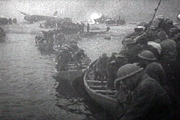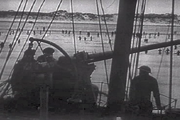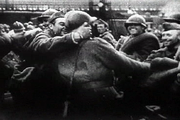
Dunkirk evacuation
About this schools Wikipedia selection
SOS Children made this Wikipedia selection alongside other schools resources. A good way to help other children is by sponsoring a child
The Dunkirk evacuation, codenamed Operation Dynamo by the British, was the large evacuation of Allied soldiers from May 26 to June 4, 1940, during the Battle of Dunkirk. British Vice Admiral Bertram Ramsay planned the operation and briefed Winston Churchill in the Dynamo Room (a room in the naval headquarters below Dover Castle which contained the dynamo that provided the electricity), giving the operation its name.
In nine days, more than three hundred thousand (331,226) soldiers — 192,226 British and 139,000 French — were rescued from Dunkirk, France and the surrounding beaches by a hastily assembled fleet of eight hundred and sixty boats. These craft included the famous "Little Ships of Dunkirk", a mixture of merchant marine boats, fishing boats, pleasure craft and RNLI lifeboats, whose civilian crews were called into service for the emergency. These small craft ferried troops from the beaches to larger ships waiting offshore, which where mainly large destroyer ships. Though the "Miracle of the Little Ships" is a prominent folk memory in Britain (and a great morale booster for the time), over 80% of the evacuated troops actually embarked from the harbour's protective mole onto the 42 destroyers and other large ships.
Progress of evacuation
Initial plans called for the recovery of 45,000 men from the British Expeditionary Force within two days, at which time it was expected that German troops would be able to block further evacuation. Only 25,000 men escaped during this period, including 7,000 on the first day. Ten additional destroyers joined the rescue effort on May 27 and attempted rescue operations in the early morning, but were unable to closely approach the beaches, although several thousand were rescued. However, the pace of evacuation from the shrinking Dunkirk pocket increased steadily.
On May 29, 47,000 British troops were rescued in spite of the first heavy air attack from the Luftwaffe in the evening. The next day, an additional 54,000 men were embarked, including the first French soldiers. 68,000 men and the commander of the BEF evacuated on May 31. A further 64,000 Allied soldiers departed on June 1, before the increasing air attacks prevented further daylight evacuation. The British rearguard departed the night of June 2, along with 60,000 French soldiers. An additional 26,000 French troops were retrieved the following night before the operation finally ended.
Two French divisions remained behind to protect the evacuation. Though they halted the German advance, they were soon captured. The remainder of the rearguard, largely French, surrendered on June 3, 1940. The next day, the BBC reported, "Major-General Harold Alexander [the commander of the rearguard] inspected the shores of Dunkirk from a motorboat this morning to make sure no-one was left behind before boarding the last ship back to Britain."
Losses
Despite the success of this operation, all the heavy equipment and vehicles were abandoned and several thousand French troops were captured in the Dunkirk pocket. Six British and three French destroyers were sunk, along with nine large boats. In addition, 19 destroyers were damaged. Over 200 of the Allied sea craft were sunk, with an equal number damaged . Winston Churchill revealed in his volumes on WWII that the Royal Air Force played a most important role protecting the retreating troops from the Luftwaffe. Without the support of the RAF, the allies would not have had such a successful evacuation. Churchill also said that the sand on the beach softened the explosions from the German bombs. The RAF lost 474 planes, compared to 132 for the Luftwaffe. However, the retreating troops were largely unaware of this vital assistance because the weather was too foggy to see them, and many bitterly accused the airmen of doing nothing to help. The French also lost a large number of ships that had nothing to do with the evacuation. Many French naval ships were idle in ports. To stop the Germans from being able to use these ships, British bomber planes were sent in to destroy the French ships.
Major ships lost
The Royal Navy's most significant losses in the operation were six destroyers:
- Grafton, sunk by U-62 on 29 May;
- Grenade, sunk by air attack off the east pier at Dunkirk on 29 May;
- Wakeful, sunk by a torpedo from a Schnellboot (E-boat) S-30 on 29 May;
- Basilisk, Havant, and Keith, sunk by air attack off the beaches on 1 June.
The French Navy lost three destroyers:
- Bourrasque, mined off Nieuport on 30 May;
- Sirocco, sunk by the Schnellboot S-23 and S-26 on 31 May;
- Le Foudroyant, sunk by air attack off the beaches on 1 June.
Aftermath
Before the operation was completed, the prognosis had been gloomy, with Winston Churchill warning the House of Commons to expect "hard and heavy tidings". Subsequently, Churchill referred to the outcome as a "miracle" and exhortations to the "Dunkirk spirit" — a phrase used to describe the tendency of the British public to pull together and overcome times of adversity — are still heard in Britain today. The British press presented the evacuation as a "Disaster Turned To Triumph" so successfully that Churchill had to remind the country, in a speech to the House of Commons on 4 June, that "we must be very careful not to assign to this deliverance the attributes of a victory. Wars are not won by evacuations."
The rescue of the British troops at Dunkirk provided a psychological boost to British morale which ended any possibility that the British would seek peace terms from Germany, since they retained the ability to defend themselves against a possible German invasion. Most of the rescued British troops were assigned to the defence of Britain. Once the threat of invasion receded, they were transferred overseas to the Middle East and other theatres, and also provided the nucleus of the army which returned to France in 1944.
The more than 100 000 evacuated French troops were quickly and efficiently shuttled to camps in various parts of south-western England where they were temporarily lodged before being repatriated. British ships ferried French troops to Brest, Cherbourg and other ports in Normandy and Brittany, although only about half of the repatriated troops were deployed against the Germans before the armistice .
In France, the perceived preference of the Royal Navy for evacuating British forces at the expense of the French led to some bitter resentment. The French Admiral Darlan originally ordered that the British forces should receive preference, but Churchill intervened at a May 31st meeting in Paris to order that the evacuation should proceed on equal terms and the British would form the rearguard. A few thousand French forces eventually surrendered, but only after the evacuation effort had been extended for a day to bring 26,175 Frenchmen to Britain on June 4th.
The very significant loss of military equipment abandoned in Dunkirk reinforced the financial dependence of the British government on the United States.
The St George's Cross flown from the jack staff is known as the Dunkirk jack, and is only flown by civilian ships and boats of all sizes which took part in the Dunkirk rescue operation in 1940. The only other ships permitted to fly this flag at the bow are those with an Admiral of the Fleet on board.








